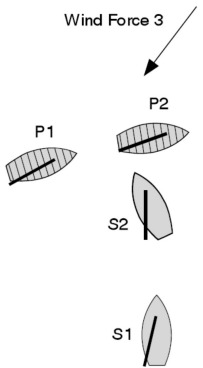Rule 10 protests involving no contact are very common, and protest
committees tend to handle them in very different ways. Some place an onus
on the port-tack boat to prove conclusively that she would have cleared the
starboard-tack boat, even when the latter’s evidence is barely worthy of
credence. No such onus appears in rule 10. Other protest committees are
reluctant to allow any rule 10 protest in the absence of contact, unless the
starboard-tack boat proves conclusively that contact would have occurred
had she not changed course. Both approaches are incorrect.
S’s diagram, later endorsed by the protest committee, shows that S bore
away to avoid contact. P’s diagram, which was not endorsed by the protest
committee, showed a near miss if S did not bear away. P did not deny or
confirm that S bore away but said that, if she did, it was unnecessary.
A starboard-tack boat in such circumstances need not hold her course so as
to prove, by hitting the port-tack boat, that a collision was inevitable.
Moreover, if she does so she will break rule 14. At a protest hearing, S must
establish either that contact would have occurred if she had held her course,
or that there was enough doubt that P could safely cross ahead to create a
reasonable apprehension of contact on S’s part and that it was unlikely that
S would have ‘no need to take avoiding action’ (see the definition Keep
Clear).
In her own defence, P must present adequate evidence to establish either
that S did not change course or that P would have safely crossed ahead of S
and that S had no need to take avoiding action. When, after considering all
the evidence, a protest committee finds that S did not change course or that
there was not a genuine and reasonable apprehension of collision on her
part, it should dismiss her protest. When, however, it is satisfied that S did
change course, that there was reasonable doubt that P could have crossed
ahead, and that S was justified in taking avoiding action by bearing away,
then P should be disqualified.
On the facts, as shown in the diagram and the report of the protest
committee, the ability of P to cross ahead of S was doubtful at best. S’s
appeal is upheld, and P is disqualified.
|
